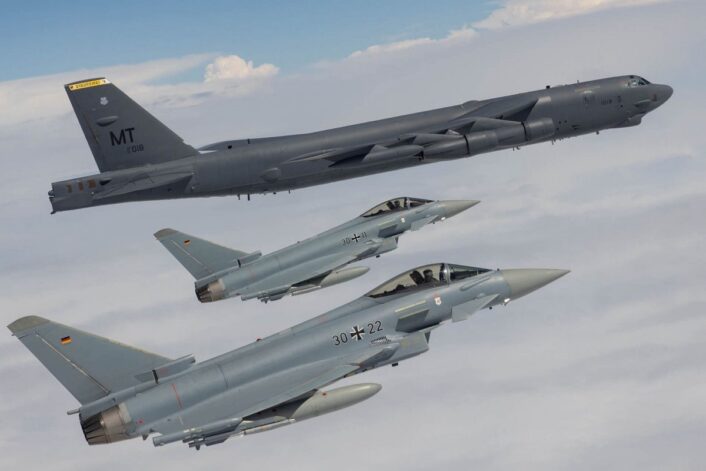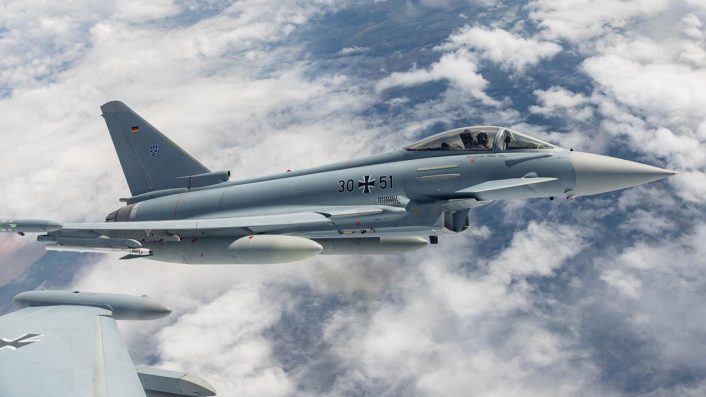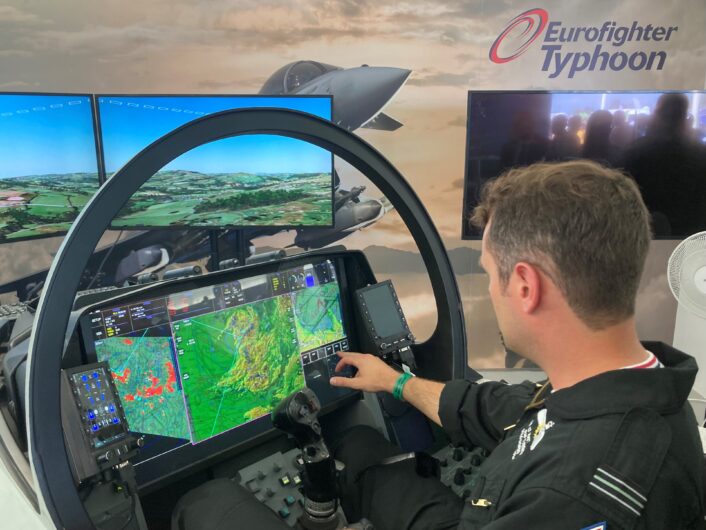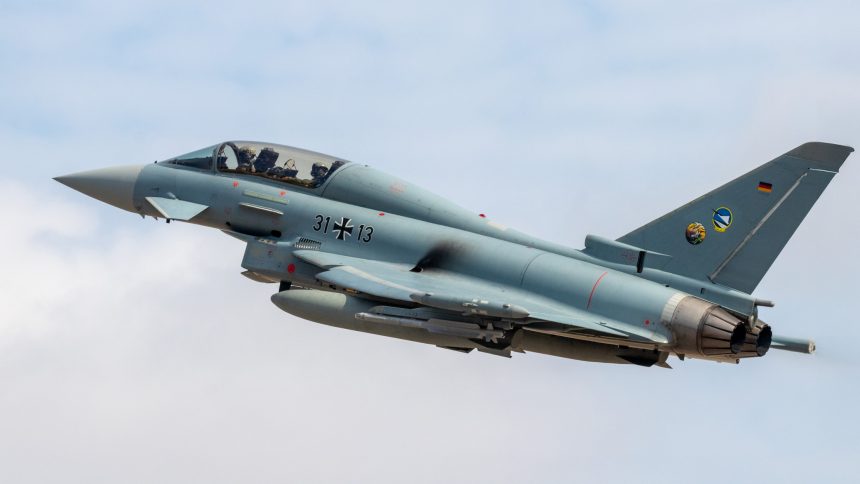The STAR demonstrator will be used to test MUM-T capabilities with the Eurofighter Typhoon, thanks to technologies developed for the Long Term Evolution integrated in a pod.
Airbus is preparing to work on a Eurofighter testbed for Manned-Unmanned Teaming (MUM-T) technologies, with a contract to start modifying a German Air Force (GAF) aircraft expected in early 2025. The System and Teaming Advanced Research (STAR) demonstrator, as it has been called, will most likely be a two-seat Eurofighter with a decoupled rear cockpit, and will be capable of controlling uncrewed aircraft systems (UAS) using data links and communications systems fitted into a pod.
According to Marco Gumbrecht, head of combat air systems at Airbus Defense and Space, initial development work is already underway. “We are taking certain parts from Eurofighter’s Long-Term Evolution (LTE) and offsetting them into an external pod to ease certification and integration,” Gumbrecht said at the International Fighter Conference on Nov. 5, 2024.
The STAR demonstrator
The mockup of the STAR pod was already displayed earlier this year next to the mockup of the Eurofighter during the International Aerospace Exhibition ILA Berlin 2024. Details about the current state of the program were however not released back then.
Some interesting new stores under the @eurofighter mock up here at #ILAAirshow #ILA24 with the Star pod to enable remote carrier operations, the @MBDAGroup RCM2 remote carrier for EW, the Eurofighter EK ELS wingtip pod and the Spice 250 guided munition from Israel. pic.twitter.com/pYVuFkkPbT
— Tony Osborne (@Rotorfocus) June 4, 2024
The platform aims to provide the GAF with an operational testbed for evaluating new crewed-uncrewed technologies, with the pod allowing a quicker integration compared to an integration in the airframe. If deemed effective, the system could be swiftly integrated into operational fleets with a progressive upgrade program, expediting the transition to future combat capabilities.
Gumbrecht emphasized the strategic shift within the industry, noting, “Industry has now understood … that we need to start breaking that [technology] road map down, not just how we can accelerate to get to a sixth-generation capability… but how can we take certain technologies … forward into the fleets that we have today.”
These efforts build upon prior crewed-uncrewed teaming experiments, including those conducted during the German Air Force’s Timber Express exercises. The STAR initiative marks a significant step towards integrating autonomous adjuncts or collaborative combat aircraft (CCA) with crewed combat aircraft, potentially transforming the landscape of aerial warfare and paving the way for the Future Combat Air System (FCAS) anticipated in the 2040s
The STAR demonstrator is set to become a critical component of Germany’s National Test and Development Center for Eurofighter (NaTE EF), slated to open in April 2025, enhancing operational test and evaluation capabilities. The NaTE EF, announced during ILA Berlin 2024, will be assigned a test aircraft and three instrumented series Eurofighter aircraft and will be stationed at Manching airport, together with the Bundeswehr’s Defense Technical Department for Aircraft and Aviation Equipment.

The Airbus Wingman
Although not mentioned by Gumbrecht, Airbus is also developing the Wingman, an unmanned fighter-type drone that will be controlled by a pilot in a current combat aircraft, such as the Eurofighter, and will handle high-risk missions that would be more hazardous for manned aircraft. The current concept envisions the Wingman enhancing the capabilities of manned combat aircraft by adding uncrewed platforms that can carry weapons and other effectors.
The mockup of the drone was unveiled at the ILA Berlin 2024, and shown near the Eurofighter mockup. The prototype of the Wingman might be tested in future with the Eurofighter STAR demonstrator for MUM-T operations.
“The German Air Force has expressed a clear need for an unmanned aircraft flying with and supporting missions of its manned fighter jets before the Future Combat Air System will be operational in 2040,” said Michael Schoellhorn, CEO of Airbus Defence and Space in the press release announcing the Wingman.
The model showcased at ILA Berlin will serve as a foundation and catalyst to refine the design requirements for future iterations of the Wingman. Specifically, this model will demonstrate all the intended capabilities, including stealth, various armament integrations, advanced sensors, connectivity, and teaming solutions.

The Long Term Evolution
The study for the Long Term Evolution (LTE) was launched in 2019 with the goal of identifying a suite of technology enhancements for the weapons system infrastructure and the engine that will ensure the aircraft remains operationally effective and can continue to spearhead the partner nations’ air forces for the decades to come, said at the time Eurofighter.
Earlier this year, the NATO Eurofighter and Tornado Management Agency (NETMA) launched the activities phase of the LTE program with a three-year technology maturation program. LTE is being developed concurrent to the ongoing Phase Enhancement (PE) upgrades and is meant to improve even more the aircraft’s capabilities as production continues.
LTE includes upgrades for the aircraft’s mission system architecture, the Praetorian defensive aids sub-system (DASS), the human-machine interface (HMI) and the EJ200 engine performance. “Everything will be data driven and data hungry,” mentioned Eurofighter, so a big part of the work will be adding processing power.
The company further mentioned that the aircraft will host top-class sensors and will elaborate and fuse data from all the source in the network. This, in turn, will require high speed data networks to ensure the bandwidth availability for the data transmission from pods and antennas, shear processing power and a state-of-the-art cockpit.

The Phase Enhancements
The aircraft currently being produced are in the Phase 3 Enhancement (P3E), which is divided in multiple stages. P3EA is itself divided in five more increments under the National Development Programme. As a whole, this stage fully integrates the Brimstone air-to-ground missile and the Meteor air-to-air missile, as well as the Litening 5 targeting pod and an improved human-machine interface in the cockpit.
The Typhoon is also receiving new AESA (Active Electronically Scanned Array) radars to replace the older mechanical radars. Called European Common Radar System (ECRS), but also known as the E-SCAN AESA radar, the new radar has three variants: ECRS Mk 0, that equips the aircraft of Kuwait and Qatar; ECRS Mk 1, that is set to equip the Typhoons from Germany and Spain; ECRS Mk2, which will also have an electronic warfare and electronic attack capacity, currently being developed for the United Kingdom.
P3EB introduced the ECRS Mk 0, allowing for its E-Scan functionality, as well as increased multi-role features and the Sniper Advanced Targeting Pod. P3EC further integrates the ECRS Mk 1 radar and increased air-to-ground functionalities. Initially, this stage should have also included the ECRS Mk 2, but it was postponed.
Eurofighter and the NATO Eurofighter & Tornado Management Agency (NETMA) announced in Jun. 2024 the development of the Phase 4 Enhancement (P4E). As the latest upgrade being developed, P4E is intended to take the Typhoon into the future, allowing it to stay relevant and integrate with 5th and even 6th gen aircraft.

Eurofighter says the P4E SD (System Definition) package contains a number of new developments, including an automated sensor management capability for all Typhoon radars. This will allow to exploit the capabilities of the new AESA (Active Electronically Scanned Array) radar to complete multiple simultaneous tasks, while reducing the pilot workload.
The package is also said to include an improved cockpit interface and enhanced Radio Frequency Interoperability (RFIO), which will improve survivability and lethality. While the development of a Large Area Display for the Typhoon has been confirmed, it is unknown at this time if it will be included in the new improved cockpit interface.
In addition to the automated sensor management capability, P4E will introduce DASS (Defensive Aids Sub-System) upgrades for all customers and includes the IOC (Initial Operating Capability) for the additional German electronic warfare capability.
The existing DASS protects the Typhoon from threats including Infra-Red and radar-guided missiles. The system’s integrated sensors and jamming equipment deliver situational awareness to the pilot and equip the aircraft with a “digital stealth capability”, achieved through advanced electronic deception techniques.
With P4E, the DASS will include a number of new capabilities, including a digital receiver capability and an electromagnetic band extension, as well as enhancements to signal processing algorithms and processor capabilities. This will allow the Praetorian system to make the most of its integration with Typhoon’s E-scan radar options, says Leonardo, with the radar complementing the DASS’ on-board jamming with its electronic attack capability.









